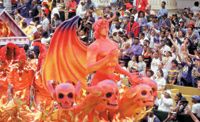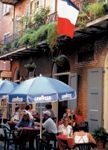- General Dermatology
- Eczema
- Alopecia
- Aesthetics
- Vitiligo
- COVID-19
- Actinic Keratosis
- Precision Medicine and Biologics
- Rare Disease
- Wound Care
- Rosacea
- Psoriasis
- Psoriatic Arthritis
- Atopic Dermatitis
- Melasma
- NP and PA
- Skin Cancer
- Hidradenitis Suppurativa
- Drug Watch
- Pigmentary Disorders
- Acne
- Pediatric Dermatology
- Practice Management
- Prurigo Nodularis
New Orleans: Feast for the senses
Attendees of this year's American Academy of Dermatology's Annual Meeting get to treat themselves to the sights, sounds and tastes of the Big Easy.

It is easy to overload the senses in this unique and history-filled city. Amazing food can be found around every corner, from the popular restaurants that visitors often frequent to the local ambiance of an unknown treasure. Great music comes from every direction and spills out of doorways right into the streets. Feast your eyes on all the architectural beauty that different cultures have brought to New Orleans over hundreds of years. With so much to take in, it's no wonder visitors to this city sometimes wish they didn't have to leave!
A place like no other New Orleans is amazing to wander through, from the ironwork in the French Quarter to the stately homes in the Garden District. Giant oaks line Esplanade Avenue and Spanish moss drips from the trees in City Park.

Heading over to the Garden District can seem as if one has entered an entirely different city, and it should. It was once a separate city (Lafayette) from the French Quarter and was established during a later period. It was created by Americans who flooded the city and clashed with the Creoles. Friction arose between the two groups and eventually Americans were kept out of the French Quarter. They moved upriver to create a residential district of their own.

Not always picturesque New Orleans wasn't always so picturesque, however. It had a rough start in its early days, including a fire that wiped out most of the city.
On March 21, 1788, flames engulfed and destroyed 850 buildings. It left virtually nothing standing. The city showed its determination and slowly rebuilt itself into something grander and sturdier.
It had been exactly 60 years before the fire that Sieur de Bienville, a French Canadian, and Scottish Minister of Finance for France, John Law, had chose the location together to create a new French city. It was named for the new Regent of France, Duc d'Orleans. Today's French Quarter is the city they mapped out with a triangle and T-square.
A must-do checklist To see this fun-filled city, it's great to start with the usual tourist attractions, but go beyond them to see the real Big Easy. Linger in a corner grocery store, sip a cold drink at a local joint or chat with a stoop-sitter.
Before heading out, brush up on "New Orleanese." In local lingo, travelers catch the streetcar on "neutral ground" (a median). When ordering a sandwich, if it's "dressed" it comes with the works. Also directions follow the river. Upriver is uptown, downriver is downtown, lakeside is toward Lake Ponchartrain, and riverside is toward the Mississippi River.
